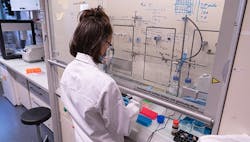Nature Promises To Upend Plastics Recycling
The protein manufacturing system used in living organisms could provide a model for a radical change in how to deal with waste plastics, hope engineers at the Ecole Polytechnique Fédérale de Lausanne (EPFL), Lausanne, Switzerland. They now have taken the first steps in a proof-of-concept project for such plastics recycling.
Using just 20 amino acids, this natural cycle can produce tens of thousands of proteins — which are polymers — with a vast array of different structures and properties. In turn, biological molecules known as ribosomes can break down these proteins into their constituent amino acids — monomers — and reassemble them into proteins with entirely different properties.
Francesco Stellacci, professor and head of the Supramolecular Nanomaterials and Interfaces Laboratory at the School of Engineering; Sebastian J. Maerkl, professor in the in the Bioengineering Institute; and PhD student Simone Giaveri wondered if a similar strategy eventually could serve to convert waste plastics into other, useful, polymers.
As a first step in the proof-of-concept, they replicated the natural cycle in a cell-free biological system. In one experiment, for example, they reduced silk to its individual amino acids and reassembled them back into a different protein used in biomedical engineering. The quality of the new protein matched that produced by living organisms. They dubbed the new process nature inspired circular-economy recycling (NaCRe).
Writing in a recent issue of Advanced Materials, the team acknowledges significant technical challenges impede transferring this thinking to industrial waste plastics, and implementation will take decades, if not centuries. However, other researchers already are making significant efforts to create a synthetic equivalent of the ribosome, they note.
For now, the Swiss researchers are focused on their own NaCRe process. “It will take a long time to upscale, although the lab is already working on it [Figure 1]. We are looking to expand it to other biopolymers and to do the process with synthetic polymers. We are also working on process optimization,” says Stellacci.
The current timescale for such a concept is so long that researchers are not now seeking industrial funding, he notes. Main support comes from the European Research Council (ERC) advanced grant system for projects with ground-breaking potential.
“The ERC has been very generous in its funding, but the time horizon is not for industry yet — although hopefully that will change.” Stellacci concludes.
